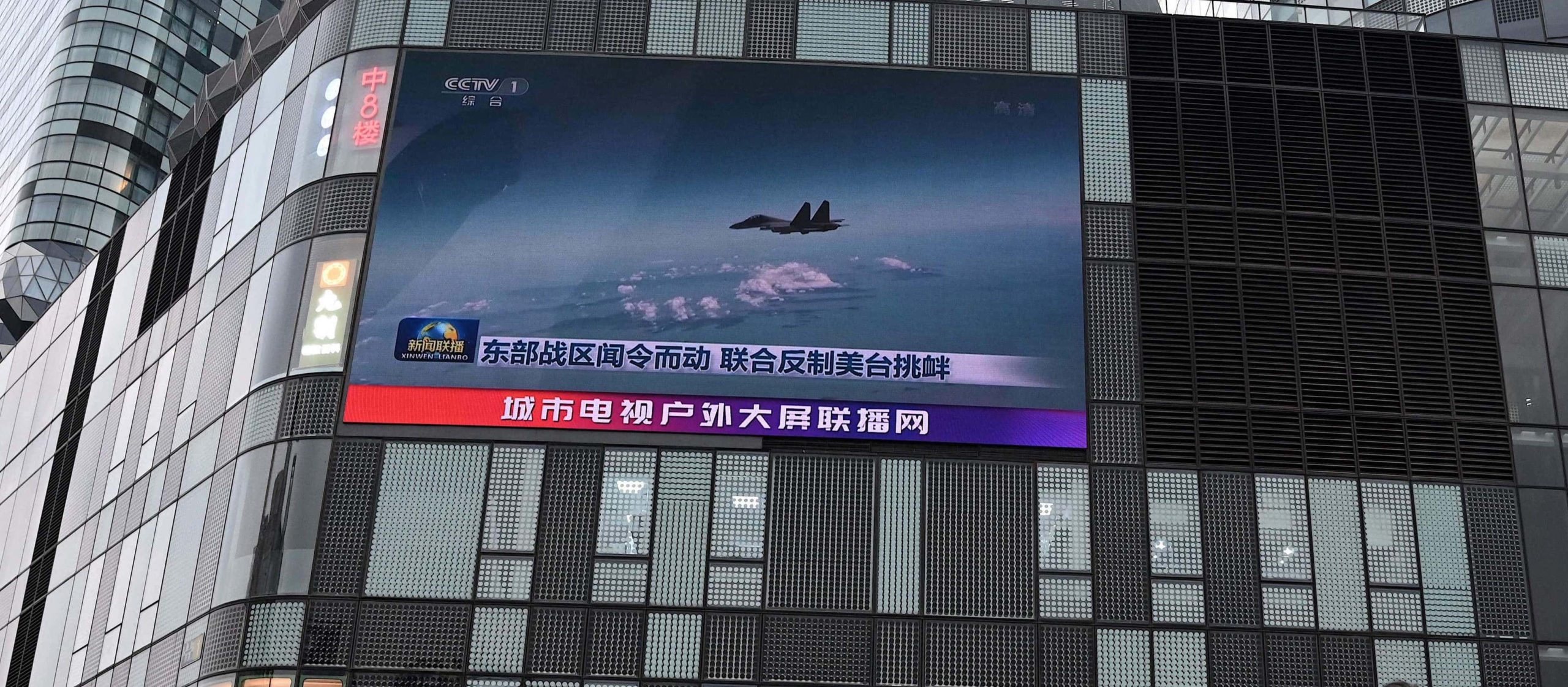This page is part of a series tracking and analyzing Chinese responses to developments amid the Fourth Taiwan Strait Crisis. Click here to explore all content in the series.
In late March and early April 2023, Taiwan’s President Tsai Ing-wen transited through the United States and held an in-person meeting with Speaker of the House Kevin McCarthy. The Chinese People’s Liberation Army (PLA) began increasing its activities as Tsai was in the United States and particularly after her meeting with McCarthy. On April 8, the day after Tsai arrived back in Taiwan, the PLA announced and launched large-scale military exercises around Taiwan. These exercises are more significant than China’s responses to past Taiwan presidential transits, and they are reminiscent of the unprecedented PLA response to then-Speaker Nancy Pelosi’s visit to Taiwan in August 2022.
In contrast to China’s major show of military force, Beijing has taken relatively less direct diplomatic and economic measures to punish Taiwan and the United States since April 2. China issued four strong statements denouncing the transit and meeting with McCarthy on April 6 and sanctioned a handful of U.S. and Taiwan entities afterwards. On April 10, China signaled desire to deepen economic and other exchanges with Taiwan. What remains to be seen is how former Taiwan President Ma Ying-jeou’s trip to China will impact domestic politics in Taiwan—a trip that was likely encouraged and at least partially orchestrated by Beijing. For example, Beijing likely welcomed Ma’s remarks to the press on April 7 after he returned to Taiwan – Ma characterized Taipei’s current leadership and policy as one leading Taiwan towards danger and war and warned that Taiwan has a choice between peace and war.
This page tracks and analyzes key activities China has taken so far, starting April 2, the week of Tsai’s meeting with Speaker McCarthy. The timelines below reflect information available through April 30, 2023.1 This page will be updated with additional analysis and new information as it becomes available. Use the table of contents below to jump to a section of the page.
Background
The meeting between President Tsai and Speaker McCarthy was framed as an alternative to an immediate visit by Speaker McCarthy to Taiwan—at least postponing his intended travel to the island. By having Tsai and McCarthy meet during an unofficial transit of the United States, there were hopes that Beijing would not escalate as much as it did when Speaker Nancy Pelosi visited Taiwan in August 2022.
China used the visit by Speaker Pelosi to provoke the Fourth Taiwan Strait Crisis, which included unprecedented military exercises around the island. Compared to the previous Taiwan Strait Crisis of 1995–1996, the August 2022 exercises were closer to the main island of Taiwan—with some of the exercise zones extending into Taiwan’s territorial waters. The PLA Rocket Force also fired multiple ballistic missiles over the main island of Taiwan, with some of them landing into the exclusive economic zones of Japan and the Philippines. Beijing also embraced limited economic punishments against Taiwan and canceled and postponed select areas of U.S.-China engagement and cooperation.
Want to learn more about China’s activities related to Speaker Pelosi’s August 2022 visit to Taiwan? Explore our feature here.
Timeline of Key Chinese Military and Related Activities
Sunday, April 2
- The PLA Eastern Theater Command reported that it sent the Type 054A frigate Xiangtan, Type 052D guided-missile destroyer Taiyuan, and Type 956EM destroyer Taizhou to conduct live-fire combat exercises in the East China Sea.
- It was reported that a combined arms brigade of the PLA Ground Force based in Guangdong received a large delivery of Type 08 wheeled armored vehicles, which are necessary for “rapid-reaction combat including rapid deployment and mobilized assault missions.”
- According to an announcement by the Liaoning Maritime Safety Administration (MSA), military exercises in the Yellow Sea and Bohai region began on April 2 and continued through April 9.
Monday, April 3
- It was reported that the Hainan, a Type 075 amphibious assault ship, carried out a joint sea-air exercise in waters to the west of China’s Guangdong Province. Official Chinese media directly linked this and other exercises to Tsai’s planned meeting with McCarthy.
- The Hainan MSA announced live-fire exercises would be held in an area off of the island’s northeastern coast from April 4–6.
Tuesday, April 4
- 14 PLA aircraft and 3 naval vessels were detected around Taiwan by Taiwan’s Ministry of National Defense (MND). Two of the detected aircraft entered Taiwan’s southwest ADIZ.
- It was reported that a combined arms brigade under the PLA 72nd Group Army held a combat-oriented beach assault exercise. The 72nd Group Army is an amphibious force that is responsible for cross-sea landing missions.
- Japan’s Maritime Self-Defense Force observed the Type 052C destroyer Changchun sailing northwest through the waters between Yonaguni Island and Taiwan on April 4. It then sailed northward through waters approximately 70 km west of the disputed Senkaku/Diaoyu Islands on April 5. The vessel had previously sailed south through the waters between the main island of Okinawa and Miyako Island on April 3.
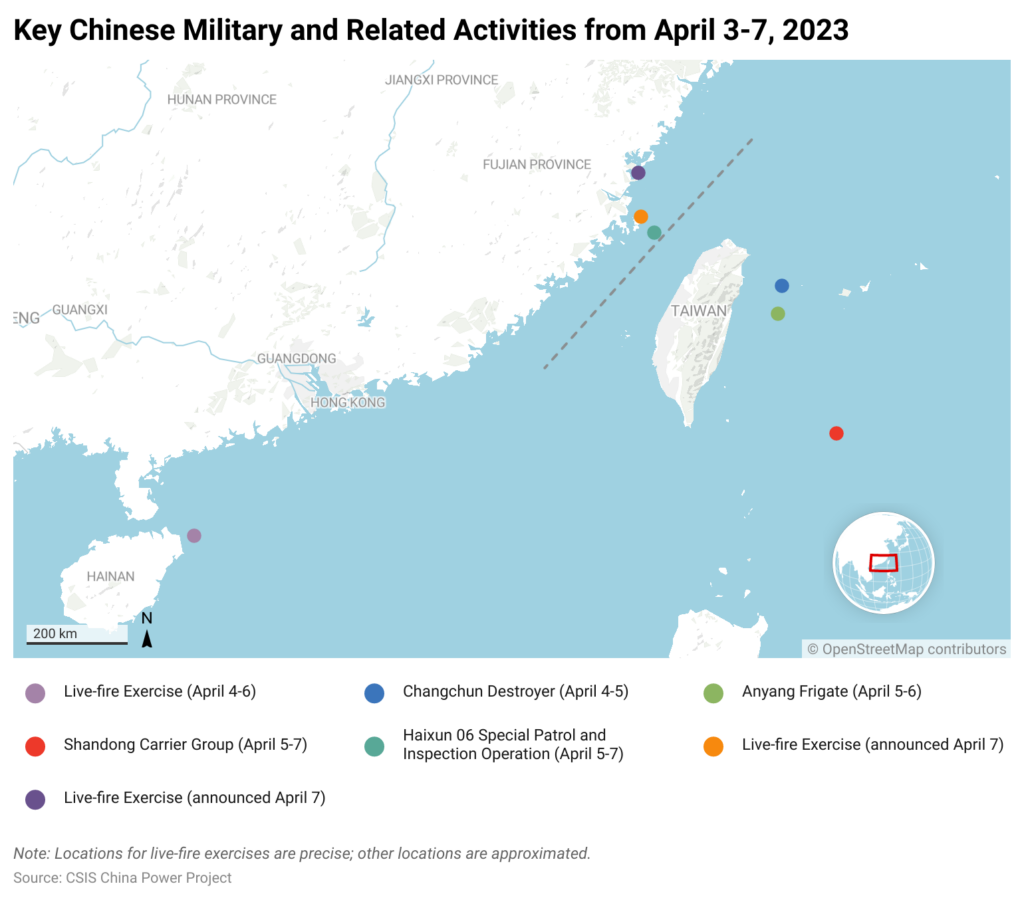
Wednesday, April 5
- China announced a three-day “special joint patrol and inspection operation” in the central and northern areas of the Taiwan Strait. As part of this operation, Chinese maritime law enforcement officials were tasked with conducting on-site inspections (现场检查) aboard vessels in the Taiwan Strait, but there were no reports of such on-site inspections taking place. The operation was led by China’s first large-scale patrol vessel in the Taiwan Strait, the Haixun 06. Vessels from the Fujian Maritime Safety Administration, East China Sea Rescue Bureau and the East China Sea Maritime Security Center joined. Notably, the first law enforcement patrol the Haixun 06 embarked on occurred during then-Speaker of the House Pelosi’s visit to Taiwan in August 2022. In response to Haixun 06’s April 2023 operations, Taiwan’s Maritime and Port Bureau issued a statement that relevant shipping companies have been told to refuse these inspections.
- The PLA Navy’s Shandong aircraft carrier passed through the Bashi Channel and into waters off of Taiwan’s southeastern coast for long-range training in the West Pacific. Japan’s Ministry of Defense (MoD) reported that the Shandong was accompanied by the Type 054A frigate Liuzhou and the Chaganhu, a Type 901 fast combat support ship. The ships traveled eastward in an area 186 miles south of Hateruma Island. Japanese guided-missile destroyer Sawagiri shadowed the carrier group. Notably, the USS Nimitz aircraft carrier was sailing about 400 nautical miles east of Taiwan that day.
- A PLA news site reported that a vessel-borne helicopter regiment affiliated with the PLA Eastern Theater Command Navy carried out landing exercises during both day and night on the Type 075 amphibious assault ship Guangxi over several days.
- Japan’s Maritime Self-Defense Force observed the Type 054A frigate Anyang sailing northwest in the waters between Yonaguni Island and Taiwan on April 5. It then sailed northward through the waters between Yonaguni Island and Taiwan, and then sailed northward through the waters approximately 80 km west of the Senkaku/Diaoyu Islands on April 6. The vessel had previously sailed south through the waters between the main island of Okinawa and Miyako on April 3.
Friday, April 7
- The Fujian MSA announced that live-fire drills would be held off the northern coast of Pingtan Island on April 10 for 13 hours. The exercise zone covers an area of approximately 39 square kilometers (15 square miles). At its closest point, the exercise zone is approximately 30 kilometers (19 miles) from Dongju Island, the southernmost island of Taiwan’s Matsu Islands. However, the announcement was later removed from the MSA website, raising questions about whether the exercises took place.
- The Fujian MSA also announced live-fire drills would be held in Luoyuan Bay, northwest of Taiwan’s Matsu Islands. The drills were scheduled from 8 am – 12 pm on April 8, 11, 13, 15, 17, and 20. However, the announcement was later removed from the MSA website, raising questions about whether the exercises took place or will later in April.
- Japan’s MoD reported that China’s Shandong aircraft carrier and its escort ships were approximately 242 miles (390 km) south of the Japanese island of Miyako.
- The Liaoning MSA announced three military exercises that would occur in the Yellow Sea and Bohai Sea. Exercises were scheduled for 8 hours on April 8 and 10 hours on April 9. Immediately following the April 9 exercise, another exercise would begin that same day, from April 9 to April 16.
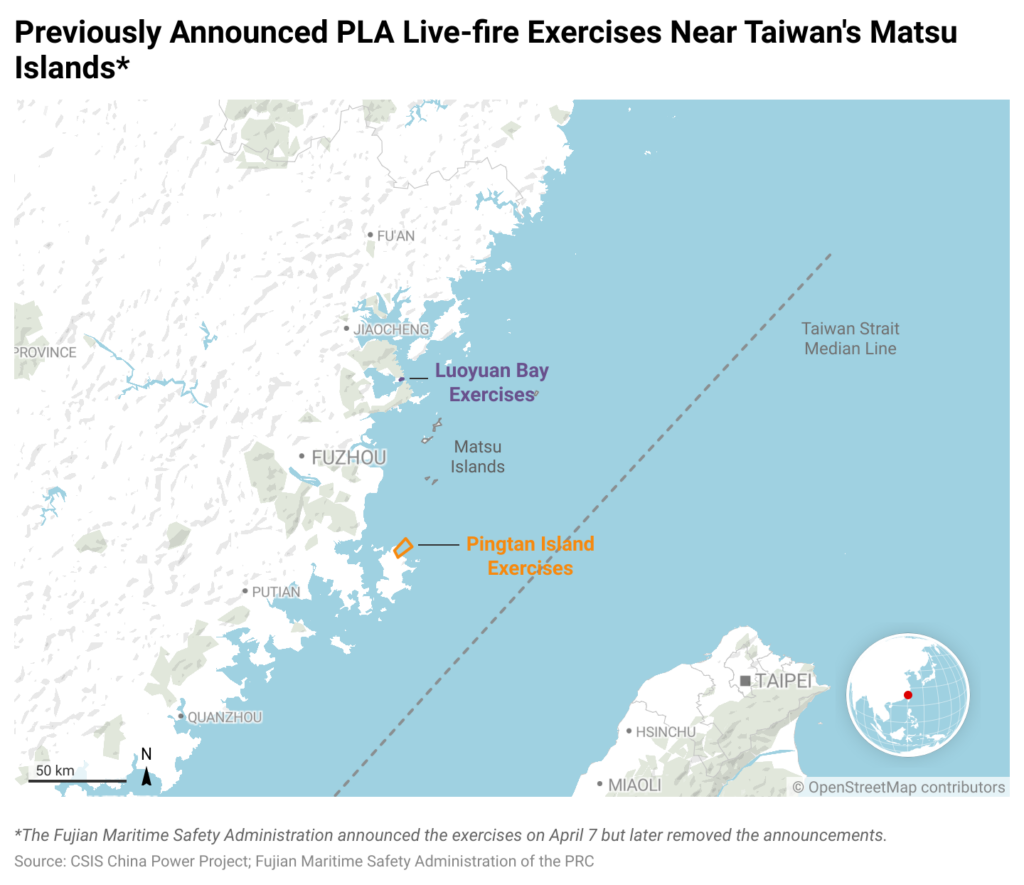
Saturday, April 8
- At 8:16 am Beijing time, the PLA Eastern Theater Command (ETC) announced that from April 8–10, it would “organize combat readiness patrols around Taiwan Island and conduct “Joint Sword” exercises in the Taiwan Strait, around the northern and southern parts of Taiwan Island, and in the sea and airspace to the east of Taiwan Island.” At 10:01 am, the ETC repeated the announcement, adding that the exercises are “a serious warning against ‘Taiwan independence’ separatist forces’ collusion and provocation with external forces, and a necessary action to safeguard national sovereignty and territorial integrity.” The exercises involved joint operations across the PLA Army, Navy, Air Force, and Rocket Forces.
- On the first day, the exercises focused on testing the PLA’s capability to seize control of sea, air, and information domains under the support of the joint combat system. PLA Navy frigates and destroyers practiced short-range assaults, long-range deterrence, and air defense and anti-missile drills. There were also joint anti-submarine drills with cooperation from police patrol boats. Dozens of J-16 and J-10C fighters carried out live ammunition and medium and long range air combat drills with the support of early warning aircraft, jammers, and refueling aircraft. PLA Rocket Force conventional missile brigades were also dispatched.
- As part of the exercises, the Type 052D destroyer Taiyuan reportedly came within 24 nautical miles of Taiwan Island—the point where Taiwan’s contiguous zone starts. This suggests Chinese vessels are operating increasingly close to the island; however, there are no reports of vessels entering Taiwan’s territorial waters (which extend 12 nautical miles from Taiwan’s territorial baseline).
- Taiwan’s MND reported that by 11 am, 42 PLA aircraft and 8 vessels were detected in areas around Taiwan. Later, Taiwan’s MND reported a total of 71 aircraft and 9 vessels around Taiwan. Up to this point, this was by far the highest figure reported in 2023, and tied for the highest ever recorded.2 Of these, 45 aircraft crossed the southern, central, and northern areas of the Taiwan Strait median line and entered into the southwest ADIZ.
- Japan’s MoD reported that the Shandong was over 267 miles (430 km) south of Miyako Island.
- Reportedly, a PLA amphibious landing ship carried out live-fire exercises just 30 miles (50 km) northwest of the Matsu Islands in the Luoyuan Bay. The vessel “fired shells at targets on land and at sea.” This aligned with an April 7 announcement by the Fujian MSA of a series of exercises over several days in the area.
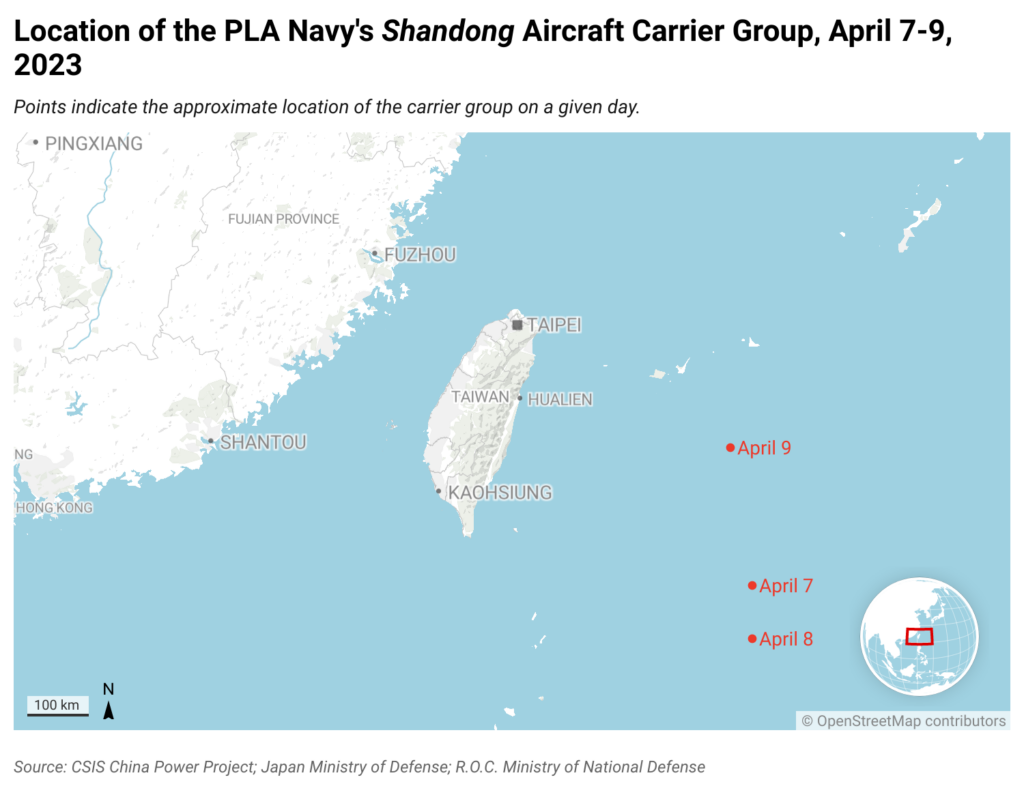
Sunday, April 9
- China continued with large-scale exercises around the island. According to a CCTV report, “Under the unified command of the theater’s Joint Operations Command Center, multiple types of units carried out simulated joint precision strikes against key targets on Taiwan Island and the surrounding waters, and continued to maintain the momentum of encircling the island.”
- As part of the exercise, several PLA aircraft and vessels worked jointly to create a “shore-sea-air joint strike system.” The PLA also released an animation that depicts several land-based assets, aircraft, and vessels launching joint precision strikes at key targets on Taiwan.
- According to reports, about 20 vessels—half from China and half from Taiwan—were engaged in a stand-off near the median line that divides the Taiwan Strait. However, details about the situation remain scant.
- Taiwan MND reported that a total of 70 PLA aircraft and 11 vessels had been detected around Taiwan that day. Of these aircraft, 35 crossed the southern, central, and northern areas of the Taiwan Strait median line and entered the southwest and southeast ADIZ. Notably, four J-15 fighters took off from the Shandong aircraft carrier and entered Taiwan’s southeastern ADIZ, marking the first time J-15s have entered the ADIZ.
- The Japanese MoD reported that the Shandong had moved north, coming within 142 miles (230 km) of Miyako Island.
Monday, April 10
- On the final day of the “Joint Sword” exercises, CCTV reporting noted that drills focused on “joint shock and deterrence and island closure and control” (联合震慑,孤岛封控). This emphasized maneuvers to cut of access to the island from seas east of Taiwan. Several destroyers and frigates carried out suppressive combat patrol missions and joint blockade simulations, and the Shandong aircraft carrier group participated in the final day of drills from the waters east of Taiwan. The carrier group consisted of one Type 055 destroyer, one Type 052D destroyer, two Type 054A frigates, one Type 901 replenishment ship, and there was likely a nuclear-powered attack submarine as well.
- Taiwan’s MND reported a record-high number of PLA aircraft around Taiwan. A total of 91 aircraft and 12 vessels had been detected. Of those aircraft, 54 crossed the Taiwan Strait median line or entered Taiwan’s southwest and southeast ADIZ. For the second day in a row, J-15 fighters entered the southeast ADIZ after presumably launching from the Shandong carrier.
- Japan’s MoD announced that between April 7-9, the Shandong carrier launched a total of roughly 120 sorties, including about 80 aircraft and 40 helicopter sorties. Japan's MoD also announced that since March 28, the PLA Type 815A electronic reconnaissance vessel Kaiyangxing had been circling Japan.
- Shortly after 6 pm, the ETC announced the successful conclusion of the “joint cruise and patrol special operation” in the Taiwan Strait.
Tuesday, April 11
- The day after the conclusion of the “Joint Sword” exercises, Taiwan’s MND reported it had detected 26 aircraft and nine vessels carrying out combat readiness patrols. In total, 35 aircraft and 8 vessels detected in the region, and 15 of these aircraft entered Taiwan’s ADIZ or crossed the Taiwan Strait median line.
- Reuters stated that there were small-scale military exercises occurring off the coast of Fuzhou, which were likely part of the previously announced exercises by Fujian MSA.
- Japan’s MoD reported that the Shandong aircraft carrier was about 180 miles (290 km) from Japan’s Miyako Island.
Wednesday, April 12
- Taiwan’s Ministry of Transportation and Communication reported that on April 11, China had issued a no-fly zone due to “aerospace activities” that China would be conducting in a busy region of airspace north of Taiwan from April 16 to 18, from 9 am to 2 pm each day. China then reduced the timeframe to just 27 minutes, from 9:30 am to 9:57 am on April 16. This zone overlaps within Taiwan’s ADIZ and is just 85 nautical miles from Taiwan’s northern coast. Taiwan’s Central News Agency reported that China’s modified "no fly zone" will impact 33 flights in total.
- Taiwan’s MND reported 26 PLA aircraft and 7 PLAN vessels around Taiwan. A total of 14 aircraft crossed the Taiwan Strait median line.
- China’s Shandong carrier group was still operating in the West Pacific, 137 miles (220 km) south of Japan’s Miyako Island.
Thursday, April 13
- China announced a new warning related to a zone north of Taiwan. The Fujian MSA announced that vessels should not enter the zone due to the possibility of falling rocket debris from 9:00 am to 3:00 pm on Sunday, April 16.
- The Hainan MSA announced four-day military exercises from April 16–19 in the South China Sea northeast of Hainan Island.
- The Shandong carrier group moved southeast, further into the West Pacific. Japan’s MoD tracked the group almost 286 miles (460 km) south-southeast of Miyako Island.
- The Liaoning MSA announced a day of military drills on April 14 in the Bohai Sea.
- Taiwan’s MND reported that it detected 4 PLA aircraft and 8 naval vessels around Taiwan. One aircraft entered Taiwan’s southwest ADIZ.
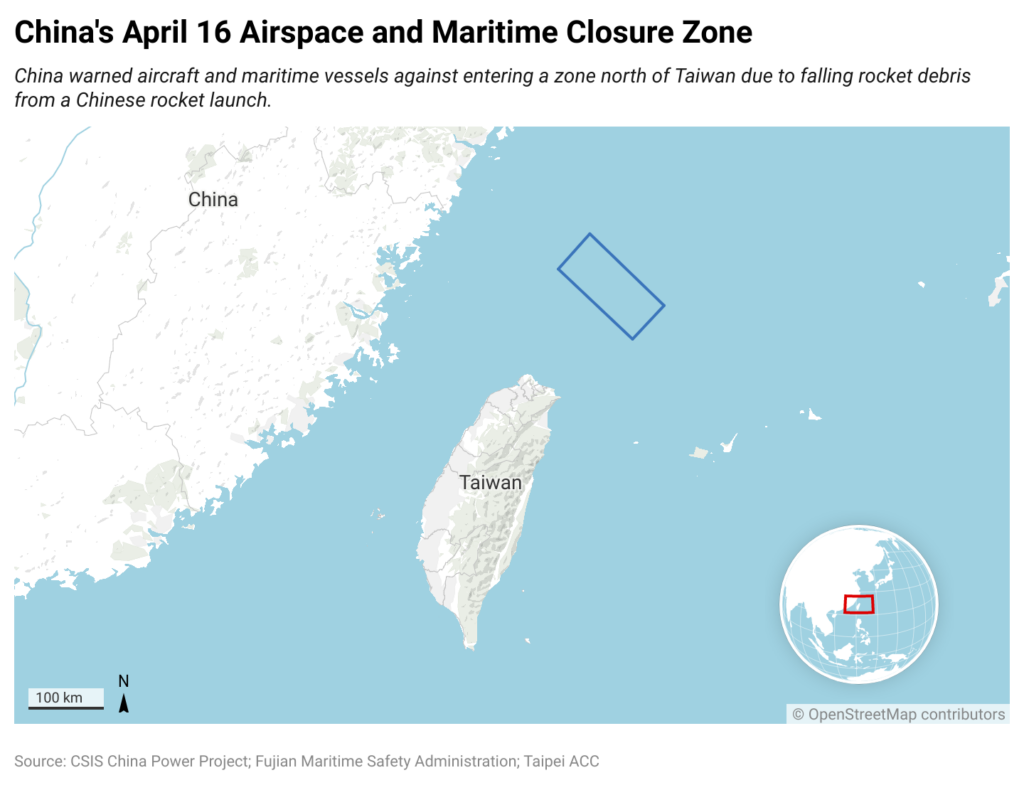
Friday, April 14
- Taiwan’s MND reported 6 PLA aircraft and 4 navy vessels around the island. Two PLA aircraft crossed the median line or entered Taiwan’s SW ADIZ.
- Regarding the airspace and maritime closure zone announced for April 16, Foreign Ministry spokesperson Wang Wenbin stated that reports describing it as a “no-fly zone” was “not accurate.”
- China’s Shandong carrier continued moving east away from Taiwan and reportedly was 323 miles (520 km) south-west of the Japanese-administers Okinotorishima reef.
- The Liaoning MSA announced three separate drills in the Bohai Sea and Bohai Strait. Two of the exercises were scheduled to last only one day on April 15 and April 16, while the third was scheduled from April 16–23.
- Taiwan’s MND reported 8 PLA aircraft and 5 PLA naval vessels around the island. Three PLA aircraft crossed the Taiwan Strait median line or entered Taiwan’s ADIZ.
Saturday, April 15
- Japan’s MoD reported that the Shandong carrier group was 230 miles (370 km) Southeast of Okinotorishima reef in the West Pacific.
- Taiwan’s Ministry of Defense observed 15 PLA aircraft and 4 PLAN vessels around Taiwan. Four of the PLA aircraft entered the southeast and southwest portions of Taiwan’s ADIZ.
Sunday, April 16
- China reported it had successfully launched a Long March-4B rocket that was carrying a meteorological satellite (Fengyun-3 07, also referred to as Fengyun-3G) from the Jiuquan Satellite Launch Center in Gansu Province. Debris from the launch was later detected in the previously announced no-fly zone. The zone was reportedly free of aircraft between 9:30 am and 10:20 am.
- The Shandong carrier was tracked by the Japanese MoD 441 miles (710 km) south-southeast of Okinotorishima reef. Additionally, Japan’s MoD reported that aircraft based on the Shandong conducted 210 sorties from April 10-16, and from April 7–16, there was a total of 330 sorties. Japan scrambled fighter jets in response to this activity.
- The USS Milius Arleigh Burke-class guided-missile destroyer sailed through the Taiwan Strait, just a week after it sailed past Chinese artificial islands in the South China Sea. China’s Ministry of Foreign affairs accused the United States of disrupting peace in the Strait. The PLA Eastern Theater Command issued a statement and ensured that they will “resolutely defend national sovereignty and regional peace.”
- Taiwan’s MND reported 18 PLA aircraft and 4 PLA navy vessels around Taiwan. Four PLA aircraft entered Taiwan’s southwest and southeast ADIZ.
Monday, April 17
- The Qingdao MSA announced 3 hours of “major” military activities on April 18 in an area of the Yellow Sea. The coordinates for the exercise indicate an area along the coast of the port city of Qingdao, but further details of the exercises were not released.
- Taiwan’s MND reported 12 PLA aircraft and 4 PLA naval vessels around Taiwan. Four of the aircraft entered Taiwan’s southwest ADIZ.
Tuesday, April 18
- Taiwan announced it plans to purchase up to 400 U.S.-made land-launched Harpoon missiles as part of deal approved in 2020 by the United States Congress.
- Reportedly, China conducted a three-hour military drill in the Yellow Sea, as announced by the Qingdao MSA the day before.
- The Guangdong MSA announced a day of military exercises on April 20 near the Pearl River Delta.
- Taiwan’s MND reported 2 PLA aircraft and 3 PLA naval vessels operating near the island. One of the aircraft entered Taiwan’s Southeast ADIZ.
Wednesday, April 19
- The Shanghai MSA announced that live-fire drills would take place on April 20 for six hours near the mouth of the Yangtze estuary.
- The Liaoning MSA announced two days of military drills in the northern Bohai Sea from April 25–27.
- The Hainan MSA announced military drills in the South China Sea from April 21–23.
- Taiwan’s MND reported 7 PLA navy vessels around Taiwan.
Thursday, April 20
- The Liaoning MSA announced new military drills in the Bohai Sea from April 21–22.
- The Shandong MSA announced military drills in the Yellow Sea near Qingdao from April 21–24. This exercise is occurring in the same location as the 3 hour long “major” military activities that took place on April 18.
- The Guangdong MSA announced three days of live-fire training from April 23–25 in the South China Sea.
- Taiwan’s MND reported 19 PLA aircraft and 5 PLA naval vessels around Taiwan. 10 aircraft crossed the Taiwan Strait median line or entered the island’s ADIZ.
Friday, April 21
- The Liaoning MSA announced military exercises in the Bohai Sea from April 23–30.
- Taiwan’s MND reported 12 PLA aircraft and 4 PLA naval vessels around Taiwan.
Saturday, April 22
- Taiwan’s MND reported 4 PLA aircraft and 3 PLA naval vessels around Taiwan. Of these aircraft, 3 entered Taiwan’s southwest and southeast ADIZ.
Sunday, April 23
- Taiwan’s MND reported 13 PLA aircraft and 3 PLA naval vessels near Taiwan. One of the aircraft entered Taiwan’s southeast ADIZ.
Monday, April 24
- The Liaoning MSA announced seven hours of military drills in the Bohai Strait scheduled to take place on April 25.
- Taiwan’s premier Chen Chien-jen revealed that the United States and Taiwan are discussing the potential for building a U.S. weapons stockpile near the region, which would grant Taiwan weapons access in the event of a cross-Strait contingency.
- Taiwan’s MND announced that the PLA Shandong aircraft carrier was detected only 120 nautical miles southeast of Taiwan’s southern tip, and the vessel was expected to sail through waters southeast of Taiwan later that day. Japan’s MoD reported that the Shandong aircraft carrier group was travelling west back towards the South China Sea
- Taiwan’s MND also reported 9 PLA aircraft and 11 PLA navy vessels around Taiwan, with one aircraft entering Taiwan’s southwest ADIZ.
Tuesday, April 25
- The Liaoning MSA announced 10 hours of military drills in the northern Bohai Sea on April 26.
- Taiwan’s MND reported 6 PLA aircraft and 4 PLA naval vessels around Taiwan. One aircraft entered the southeast ADIZ region.
Wednesday, April 26
- The Hainan MSA announced four hours of military drills to take place on April 27.
- Taiwan’s MND reported 12 PLA aircraft and 4 PLA naval vessels around Taiwan. Five aircraft either crossed the Taiwan Strait median line of entered Taiwan’s southwest ADIZ.
Thursday, April 27
- The Liaoning MSA announced that military exercises will take place in the Yellow Sea between April 30 and May 7.
- Taiwan’s MND reported 38 PLA aircraft and 6 PLA naval vessels around Taiwan, marking a high point in Chinese activity since the end of major exercises in early April. 19 of the detected aircraft either crossed the median line or entered Taiwan’s ADIZ. Notably, a Chinese TB-001 Scorpion UAV encircled Taiwan on its southern, eastern, and northern sides.
Friday, April 28
- Taiwan’s MND reported that 17 PLA aircraft and 8 PLA naval vessels were around Taiwan. 13 of the detected aircraft either crossed the Taiwan Strait median line or entered Taiwan’s ADIZ.
Saturday, April 29
- Taiwan’s MND detected 10 PLA aircraft and 6 PLA naval vessels around Taiwan. One of the detected aircraft entered Taiwan’s southwest ADIZ.
- The Japanese MoD reported three Chinese ships sailing between Okinawa and Miyako Island towards the west Pacific. The three ships were a guided missile destroyer, a frigate, and a supply ship. Japan’s MoD also detected a Chinese intelligence ship sailing north through the Tsushima Strait.
Sunday, April 30
- Taiwan’s MND reported 7 PLA aircraft and 3 PLA naval vessels around Taiwan. Two aircraft entered Taiwan’s southwest ADIZ.
- The Japanese MoD tracked five Chinese ships as they sailed north through the Tsushima Strait, including three guided missile destroyers, one frigate and a replenishment ship.
Timeline of Key Chinese Diplomatic and Non-Military Activities
Similar to its military activities, China’s direct diplomatic and non-military responses escalated after the Tsai-McCarthy meeting. From April 6 onwards, China embraced sanctions on select U.S. and Taiwan entities. Beijing, however, appears to be balancing its desire to punish Tsai and the current government in Taipei with a broader imperative to increase various forms of economic and political exchanges between China and Taiwan.
Tuesday, April 4
- One day prior to the Tsai-McCarthy meeting, the congressional liaison at the Chinese embassy in Washington Li Xiang sent an email to members of Congress who would be in attendance at the meeting, urging them to not meet with Tsai. Li warned that China opposes “any form of official interaction between the US and Taiwan” and that China “will most likely take necessary and resolute actions in response.”
Thursday, April 6
- In a highly orchestrated public move, four major Chinese government actors and departments each issued public statements denouncing Tsai’s transit and meeting with Speaker McCarthy.
- China’s top legislative body, the National People’s Congress, asserted, “The action of McCarthy, the third highest-ranking official of the U.S. government, has seriously broken the commitment made by the United States to China on the Taiwan question” and it reiterated that “the Taiwan issue” is “the first red line that must not be crossed in China-U.S. relations.”
- The Ministry of Foreign Affairs (MFA) issued a statement that warned that “‘Taiwan independence’ and cross-Strait peace and stability are as irreconcilable as fire and water,” promising that “the pursuit of ‘Taiwan independence’ will lead nowhere.”
- The State Council’s Taiwan Affairs Office condemned the “DPP authorities” who “promote Taiwan-US collusion.” It noted that Tsai and the DPP are pushing Taiwan toward a dangerous brink of potential conflict. The office warned that it “will take firm measures to punish the ‘Taiwan independence’ separatist forces and their actions” and “any act of seeking ‘independence’ will be smashed to pieces under the powerful force of the Chinese sons and daughters to oppose ‘independence’ and promote reunification.”
- China’s MND issued a statement saying that the PLA “sticks to its duties and missions” and “resolutely defends national sovereignty and territorial integrity.”
Friday, April 7
- The Taiwan Work Office issued sanctions on certain institutions and individuals in both Taiwan and the United States. Hsiao Bi-khim, Taiwan’s representative to the United States, was sanctioned for a second time. The sanctions bar her from entering mainland China, Hong Kong, or Macao due to her “diehard” support for “Taiwan independence.” China also sanctioned the leaders of Taiwan’s Prospect Foundation (a think tank focusing on cross-Strait relations) and the Council of Asian Liberals and Democrats (a regional organization of liberal democratic political parties in Asia). In the United States, China sanctioned the Hudson Institute and the Ronald Reagan Presidential Library, and specific administrators at each organization, freezing any assets they had in China and barring them from entering the country.
- In a MFA press conference, spokesperson Mao Ning emphasized that “the Taiwan question is not about democracy, but about China’s sovereignty and territorial integrity,” claiming “the sovereignty and territory of China have never been divided and shall never be divided.” She asserted that “the future of Taiwan lies in China’s reunification, and the wellbeing of the people in Taiwan hinges on the rejuvenation of the Chinese nation.”
Monday, April 10
- Foreign Ministry spokesperson Wang Wenbin said “the combat readiness security patrol encircling the Taiwan Island and the ‘Joint Sword’ exercises is a stern warning to the provocative activities of ‘Taiwan independence’”secessionist forces and their collusion with external forces,” highlighting the exercises as “a necessary move to safeguard national sovereignty and territorial integrity.”
- Wang Huning, a Politburo Standing Committee member and chairman of the National Committee of the Chinese People’s Political Consultative Conference, met with a delegation of Taiwan business executives led by Liu Chao-shiuan, co-president of the Cross-Strait CEO Summit in Beijing. Wang messaged the desire for improved economic and trade exchanges and that peace and stability in the Taiwan Strait “cannot be realized with the existence of ‘Taiwan independence.’”
Wednesday, April 12
- China’s Ministry of Commerce announced it was launching an investigation into Taiwan’s trade restrictions on over 2,400 mainland goods at the request of several trade groups. Taiwan’s Mainland Affairs Council warned that the investigation will not improve cross-strait trade but make future cooperation more difficult.
Wednesday, April 19
- Amid speculation that China’s investigation into trade barriers between Taiwan and the mainland would result in the termination of the Economic Cooperation Framework Agreement (ECTA) that was signed in 2010, Taiwan’s Mainland Affairs Council urged Beijing to keep the ECTA in place.
- China’s Taiwan Affairs Office added Lockheed Martin and Raytheon to its list of “Unreliable Entities” after arms manufactured by both companies were sold to Taiwan. Senior executives from both companies are now barred from China.
Wednesday, April 26
- China confirmed that it had arrested Li Yanhe (penname Fucha), a Taiwan-based publisher on the grounds that his activities were "endangering national security." News of his arrest came a day after Chinese authorities announced the formal arrest of a leading Taiwanese nationalist politician for “secession” whom they detained in August 2022.
Authors:
Bonny Lin, Brian Hart, Samantha Lu, Hannah Price, Matthew Slade


